The advent of technology has completely transformed how people meet and start relationships. Online dating platforms, chatting apps, and matrimonial websites have made finding a partner for humans extremely easy and convenient.
However, the same cannot be said about the animal kingdom, they have to rely on good old traditional methods to impress their mates. While all animals have some special skills to attract a partner, Bird species take courtship to another level.
When it comes to the type of relationship, depending on the species, birds can follow diverse strategies. Birds can be monogamous, where birds form a relationship with a single mate for a breeding season or lifetime, and polygamous, which includes both polygyny (one male with multiple females) and polyandry (one female with several males).
Whether monogamy or polygamy, courtship display in the bird species is extremely flamboyant, skillful, attractive, and creative.
Generally, the male bird begins the courtship, showing off his talents and skills to females who assess the performance to choose the fittest, healthy, and most worthy mate. The parameters to evaluate the performance are mostly the appearance of plumage, dance steps, or vocalizations.
Even their nesting behavior is extremely diverse, most often it is found that females raise their chicks. Therefore it is essential that female birds carefully assess the best partner. A healthy and fit male will pass on good genes which will maximize the chances of producing healthy offspring.
Here is the list of 9 bird species and their courtship displays.
Birds of Paradise
Found in the forests of Australia and New Guinea, the male species of Birds of Paradise is one of the best dancers in the wildlife. The shakes, jiggles, and movements, while doing their courtship rituals, can compete with any performers in any dance show or talent hunt competition.
There are more than 42 species of birds of paradise in the family Paradisaeidae and each of them has their unique dance moves and outlandish displays.
Western Parotia, one of the species in the Birds of Paradise family can compete with any professional ballerina dancer. He shapes his feathers like a round skirt and performs a series of wild head moves and synchronized footsteps, which the female watches from above.
Male Lophorina (superb Bird of Paradise), endemic to New Guinea, spreads out its black feathers like a fan such that its bright blue-green breastplate is only visible. Then when the female is ready to view the performance, he hops around showing the flamboyant colours of his breastplate and the eyes.
We have written on the Birds of Paradise. You can read it here.
Blue-Footed Boobies
Most of the birds indulge in the courtship dance with their vibrant plumage on their bodies, Blue-footed Boobies rely on their feet.
Blue-footed Boobies birds are mostly found along the Pacific coast in Mexico’s Gulf of California, Peru, and the Galápagos Islands. As the name defines these birds, their blue-colored feet are the highlight of their white body.
During the courtship display, the male shows off the brightness of his feet by lifting their legs and exaggerating their walk. Females are attracted to males with the brightest blue feet as it indicates youthfulness and higher competence.
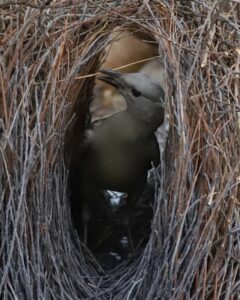
Bowerbirds
The courtship displays of Bowerbirds are not about performance or dance, it is like creating an experience for their future mate.
There are more than 20 species of Bowerbirds and each male species builds elaborate and complex structures called bowers with twigs. Then they decorate the bowers with objects like brightly colored stones, fresh flowers, fruits, or sometimes waste collected or stolen from human habitations.
The idea is to make an impressive bower that attracts a female. Once she enters the structure, the male Bowerbird performs dance moves and other freaky steps, even picking objects in their beaks like props or gifts.
We have written on the Bowerbirds. You can read it here.
Magnificent Frigatebirds
Magnificent Frigatebirds are large seabirds found along the coast in the southern United States, Mexico, and the Caribbean.
While they spend most of their time flying over the oceans when it comes to finding a potential partner, male species of magnificent frigatebirds leverage a unique inflatable throat pouch called a gular sac found on their throat.
During the breeding season, large colonies of frigatebirds gather on coastal islands.
To find a mate, males inflate their throat pouch to look like a large red balloon. These sacs, while inflated, can get so large that they obscure the bird’s head. They also raise their bills to provide maximum visibility of their red sacs along with shaking their wings and making loud drumming sounds.
Once females have selected one mate for the season, they will lay one egg on the nests which are often clustered close together and built by females who use materials brought to them by the mates they choose.
We have covered these birds in our list of weird animals in the wildlife. You can read it here.
Manakins
The Manakins (subfamily: Pipridae) are small passerine birds found in tropical regions of South America.
The group contains more than 50 species and for most of them, their courtship dances are cooperative rather than competitive. The courtship displays occur on slender stems or branches, where once the female settles, more than one male will come next to it and perform a synchronized display.
Take the case of male Lance-tailed manakin identified by black bodies with bright blue colors on the upper body, and dark red colors on the forehead, as if wearing a cap. When the female is perched on a branch for the courtship ritual, two males of Lance-tailed manakin jump up and down over each other alternatively in a synchronized routine.
There are other more famous Red-capped manakins identified by a red forehead on their black bodies. The male Red-capped manakins perform a dance move reminiscent of Micheal Jackson’s moonwalk as part of the courtship display. Their dance is done individually by sliding forward and then quickly gliding backward on a branch.
Mastering the art of this group dancing isn’t easy as males take years to practice and coordinate dance moves. However, only the alpha male gets to mate with receptive females, and the group mates learn to become alpha later.
Mandarin Ducks
Mandarin ducks are one of the most beautiful birds you can see in wildlife, with a multitude of colors and different shades all over their body.
These ducks are found in Far East regions like China, Japan, Korea, Taiwan, and parts of Russia.
The courtship display of male Mandarin Ducks includes bobbing, shaking, and mock-drinking. They also raise their crest and sail feathers to show off.
Mandarin ducks are a symbol of love as they often form long bonds with their partners.
Flamingos
To the human eye, Flamingo’s courtship display is like ‘poetry in motion’ as the movements provide a fascinating visual spectacle.
Flamingos are found in many parts of the world and perform a highly synchronized ritual to attract mates.
Like Manakins, courtship displays of Flamingos are also collective and cooperative. During the breeding season, several individuals perform a series of distinct movements and postures. This synchronized behavior is crucial for attracting mates and establishing pair bonds.
Some dance movements include raising their heads with necks straight and rhythmically moving them from side to side, spreading their wings to reveal vibrant colors while holding their necks extended, and even giving calls to each other, enhancing the communal aspect of the courtship ritual.
These movements and postures demonstrate the physical prowess of the bird and strengthen social bonds within the colony. The more adept a flamingo is at performing these movements, the better its chances of securing a partner.
Flamingos generally form pair bonds that last for a single breeding season, necessitating a new display each year to attract a mate.
Greater Sage-Grouse
Greater Sage-Grouse are found in brushy western plains of North America.
During the springtime, these birds congregate on traditional display grounds known as leks to begin a new mating season. Many of these leks have been used for many, many generations.
Males of greater sage-grouse are known for their spiky pointed tail feathers. To impress the females, the males Greater Sage-Grouse fan out their spiked tail feathers and rapidly inflate and deflate the balloon-like air sacs on their necks. As part of the process, they make weird noises of booming, swishing, and popping, some of which are also produced due to their wings and throat movements.
Although many male sage-grouse gather to display at a lek, only a few are chosen by the females for mating. After mating, the females disperse around the lek to build nests and lay eggs.
Peafowls
Peafowls’ grand show of courtship display is one of the most well-known dances in the animal kingdom.
These birds are native to India and the South Asian region. The male species (peacocks) are known for their long tail feathers and beautiful colors.
During the mating seasons, Peacocks raise this massive collection of dazzling tail feathers upright, displaying intricate patterns composed of iridescent blue and turquoise greens. They also strut back and forth to shake the feathers, giving signals to the potential mate.
This extravagant display requires energy and muscular power to perform.
The visiting female peahen stops directly in front of the male to evaluate the male with the longest, most colorful tails as it indicates good health status.
We all know about the brightly colored Peacocks, but do you know there are White Peafowls? Read here.
Wrapping Up
So let us end this by mentioning that once the romance and courtship display is over, the female bird invests a great deal of energy in producing eggs, incubating them, and raising the young chicks, thus keeping the beautiful process of evolution in our biodiversity.
You can watch the video of the courtship dances of the birds and other interesting nature-related videos on the Change Started YouTube channel.

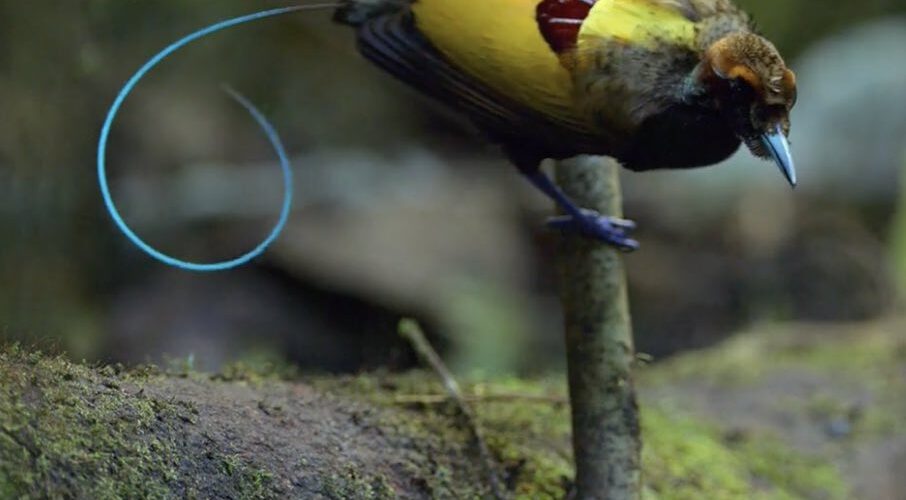
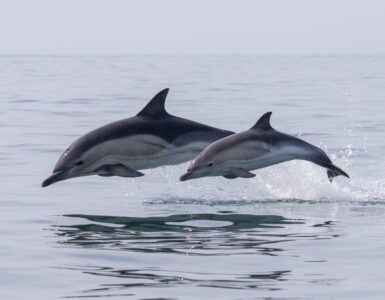
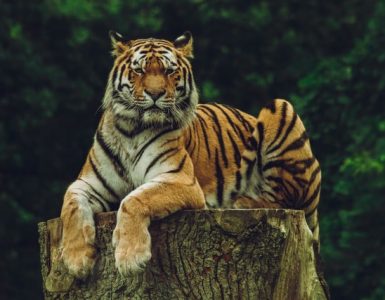
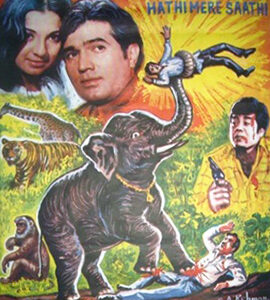

Add comment